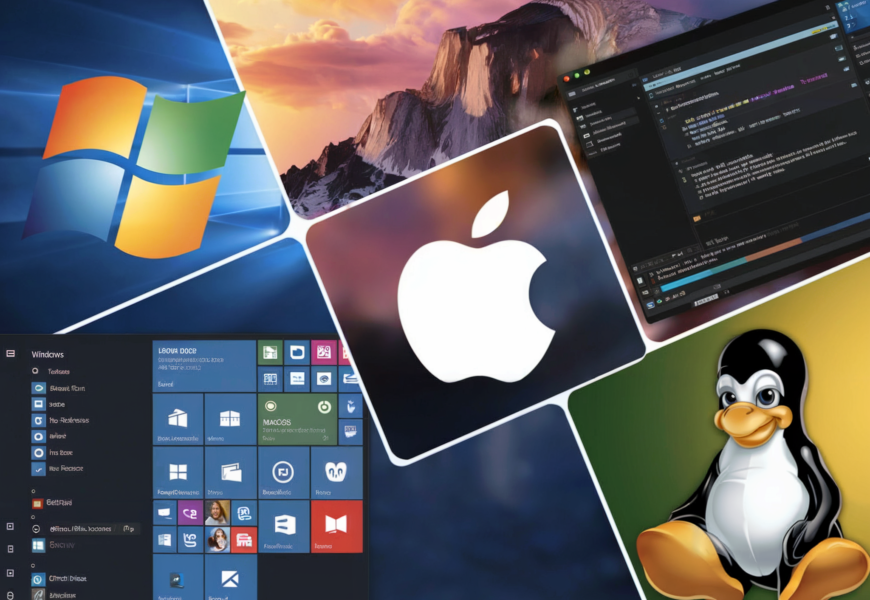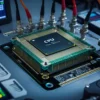Choosing the right operating system is crucial in today’s digital landscape, as it significantly impacts your computing experience. Whether you’re a casual user, a creative professional, or a tech enthusiast, understanding the strengths and weaknesses of each major OS is essential. In 2024, the competition between Windows, macOS, and Linux continues to evolve, with each platform offering unique features and capabilities. This comparison will help you navigate the world of operating systems and find the perfect fit for your needs.
Did you know that Windows powers more than 1.4 billion PCs worldwide? That’s an astounding number! But does popularity always equate to being the best choice for everyone? Not necessarily. Let’s embark on a journey through the world of operating systems and explore which one might be the perfect fit for your needs and preferences.
Market Share and Popularity
When it comes to desktop operating systems, the market share breakdown paints an interesting picture:
- Windows dominates with approximately 80% market share
- macOS holds about 15% of the market
- Linux-based operating systems account for roughly 3%
But what factors contribute to each OS’s popularity? Let’s break it down:
Windows: The Familiar Giant
Windows’ massive market share can be attributed to several factors:
- Pre-installed on most PCs: Many computers come with Windows pre-installed, making it the default choice for many users.
- Business and enterprise adoption: Windows has long been the go-to OS for businesses, thanks to its widespread compatibility and management tools.
- Gaming support: Windows is the preferred platform for PC gaming, with extensive support for the latest titles and hardware.
- Familiarity: Many users have grown up using Windows, making it a comfortable choice.
macOS: The Apple Ecosystem
While macOS has a smaller market share, it has a devoted following:
- Integration with Apple devices: macOS works seamlessly with iPhones, iPads, and other Apple products.
- Creative professional preference: Many creative industries favor Macs for their design software and performance.
- User experience: Apple’s focus on a sleek, intuitive interface appeals to many users.
- Brand loyalty: Apple has cultivated a strong brand identity, leading to high customer loyalty.
Linux: The Open-Source Underdog
Linux may have a smaller market share, but it’s beloved by many for several reasons:
- Open-source nature: Linux is free and open-source, appealing to those who value transparency and customization.
- Server dominance: While not reflected in desktop market share, Linux powers a significant portion of web servers.
- Security and privacy: Many users choose Linux for its reputation for strong security and privacy features.
- Community support: The Linux community is known for its helpfulness and wealth of resources.
User Interface and Ease of Use
The user interface (UI) is often the first thing users interact with, making it a crucial aspect of any operating system. Let’s compare how Windows, macOS, and Linux stack up in terms of UI and ease of use:
Windows: Familiar Territory with Modern Updates
Windows has come a long way since its inception, and Windows 11 brings a fresh look to the familiar interface:
- Start menu: Centered by default, with a simplified layout for easy access to apps and files.
- Taskbar: Streamlined design with centered icons, similar to macOS.
- File Explorer: Updated with a more modern look and improved functionality.
- Settings app: Redesigned for easier navigation and a more cohesive experience.
Windows strikes a balance between familiarity and innovation, making it relatively easy for most users to adapt to new versions.
macOS: Sleek and Intuitive
Apple’s macOS is known for its clean, intuitive design:
- Dock: Quick access to frequently used apps and files.
- Menu bar: Consistent across applications, providing easy access to system-wide functions.
- Mission Control: Efficient management of open windows and virtual desktops.
- Spotlight: Powerful search function for finding files, launching apps, and performing quick calculations.
macOS’s design philosophy focuses on simplicity and elegance, which many users find appealing and easy to navigate.
Linux: Customization King
Linux offers a variety of desktop environments, each with its own UI:
- GNOME: Modern, minimalist interface focused on simplicity.
- KDE Plasma: Highly customizable with a more traditional desktop layout.
- Xfce: Lightweight and fast, ideal for older hardware.
- Cinnamon: Developed for Linux Mint, offering a familiar Windows-like experience.
The variety of options in Linux allows users to choose an interface that best suits their preferences and workflow.
Learning Curves for New Users
- Windows: Generally easy for most users, especially those with prior Windows experience.
- macOS: Intuitive for many, but may require some adjustment for long-time Windows users.
- Linux: This can vary depending on the distribution and desktop environment chosen. Some distributions, like Ubuntu or Linux Mint, are designed to be user-friendly for beginners.
Performance and Hardware Compatibility
Performance and hardware compatibility are crucial factors when choosing an operating system. Let’s examine how each OS fares in these areas:
Windows: Jack of All Trades
Windows boasts extensive hardware support:
- Wide range of compatible devices: From budget laptops to high-end gaming rigs.
- Driver support: Most hardware manufacturers provide Windows drivers.
- Gaming performance: Generally considered the best OS for gaming due to widespread support and optimizations.
Performance can vary depending on the hardware and version of Windows. Windows 11 has shown improvements in areas like boot times and overall responsiveness compared to previous versions.
macOS: Optimized for Apple Hardware
macOS is designed specifically for Apple’s hardware:
- Tight integration: Optimized performance on MacBooks, iMacs, and Mac Minis.
- Limited hardware options: Only runs on Apple devices, restricting choice but ensuring compatibility.
- Consistent performance: Generally smooth and responsive across supported devices.
The close relationship between hardware and software often results in a more stable and optimized experience for macOS users.
Linux: Versatile Performer
Linux can run on a wide variety of hardware configurations:
- Lightweight options: Distributions like Lubuntu or Puppy Linux can breathe new life into older hardware.
- Server performance: Excels in server environments, powering much of the internet’s infrastructure.
- Customizable kernels: Advanced users can optimize the OS for specific hardware or use cases.
Performance on Linux can vary greatly depending on the distribution, desktop environment, and hardware configuration.
Benchmarking and Real-world Performance
When it comes to raw performance, benchmarks often show that:
- Windows and Linux tend to perform similarly on equivalent hardware.
- macOS can outperform in certain tasks, especially on Apple Silicon Macs.
- Linux often has an edge in server and development environments.
However, real-world performance is about more than just benchmark numbers. Factors like software optimization, user experience, and specific use cases all play a role in perceived performance.
Security and Privacy Features
In an era of increasing cyber threats and privacy concerns, the security features of an operating system are more important than ever. Let’s compare how Windows, macOS, and Linux approach security and privacy:
Windows: Regular Updates and Built-in Tools
Microsoft has made significant strides in improving Windows security:
- Windows Defender: Built-in antivirus and anti-malware protection.
- Regular security updates: Frequent patches to address vulnerabilities.
- Windows Hello: Biometric authentication for secure login.
- BitLocker: Full disk encryption to protect data.
Despite these features, Windows remains a primary target for malware due to its large user base.
macOS: Strong Security Out of the Box
Apple’s macOS has a reputation for robust security:
- Gatekeeper: Prevents unauthorized applications from running.
- XProtect: Built-in malware detection and removal.
- FileVault: Full disk encryption similar to BitLocker.
- App Store vetting: Stricter app approval process for increased security.
While macOS is generally considered more secure than Windows, it’s not immune to threats, and its growing popularity has led to increased targeting by malware creators.
Linux: Open-Source Security
Linux’s security model is based on its open-source nature and community-driven development:
- Frequent updates: Security patches are often released quickly due to the open-source model.
- User permissions: Strict separation of user and system files enhances security.
- Diverse ecosystem: The variety of Linux distributions can make it harder for malware to target the OS broadly.
- Transparency: Open-source code allows for community scrutiny and rapid identification of vulnerabilities.
Linux is often considered the most secure of the three, particularly for advanced users who understand how to properly configure their system.
Comparison of Vulnerability Rates and Privacy Concerns
- Windows: Historically has had the highest number of reported vulnerabilities, partly due to its large user base and status as a prime target for attackers.
- macOS: Generally has fewer reported vulnerabilities than Windows, but the number has been increasing in recent years.
- Linux: Often has the lowest number of reported vulnerabilities, though this can vary depending on the specific distribution.
Privacy concerns also differ:
- Windows: Has faced criticism for data collection practices, though Microsoft has made efforts to increase transparency and user control.
- macOS: Apple emphasizes privacy as a key selling point, with features like App Tracking Transparency and Privacy Labels.
- Linux: Generally considered the best for privacy due to its open-source nature and lack of built-in tracking features.
Software Availability and Compatibility
The availability of software and compatibility with various applications can be a deciding factor when choosing an operating system. Let’s explore how each platform fares in this area:
Windows: Extensive Software Library
Windows boasts the largest selection of software:
- Business applications: Most enterprise software is developed for Windows first.
- Gaming: Unparalleled support for PC games, both new and old.
- Legacy software: Strong backward compatibility allows many older programs to run on newer versions of Windows.
The sheer volume of software available for Windows is one of its strongest selling points.
macOS: Apple Ecosystem and Creative Tools
macOS has a strong focus on creative and professional software:
- Apple ecosystem: Seamless integration with iOS apps and services.
- Creative suite: Industry-standard tools like Final Cut Pro and Logic Pro.
- Professional software: Many design and development tools have macOS versions.
While the selection is smaller than Windows, macOS users often praise the quality and integration of available software.
Linux: Open-Source Alternatives and Growing Compatibility
Linux offers a mix of open-source and proprietary software options:
- Open-source alternatives: GIMP for image editing, LibreOffice for productivity, etc.
- Growing compatibility: Increasing support for popular applications through tools like Wine or native Linux versions.
- Development tools: Excellent selection of programming and development environments.
While Linux has traditionally lagged behind in software availability, the situation has improved significantly in recent years.
Cross-Platform Software Options
Many popular applications are now available across all three platforms:
- Web browsers: Chrome, Firefox, and others work on all major operating systems.
- Productivity suites: Microsoft Office and Google Workspace are accessible on Windows, macOS, and Linux.
- Creative tools: Adobe Creative Cloud supports both Windows and macOS, with some Linux alternatives available.
The rise of web-based applications has also helped bridge the gap between different operating systems.
Customization and Flexibility
The ability to tailor an operating system to your specific needs and preferences can greatly enhance your computing experience. Let’s compare the customization options available in Windows, macOS, and Linux:
Windows: Limited Built-in Options, Third-Party Tools Available
Windows offers some customization options out of the box:
- Start menu layout: Customizable tiles and app list.
- Taskbar settings: Adjust position, auto-hide, and icon size.
- Theme and color schemes: Change wallpapers, accent colors, and light/dark modes.
For more extensive customization, users often turn to third-party tools:
- Rainmeter: Create custom desktop widgets and information displays.
- Classic Shell: Modify the Start menu and File Explorer interface.
- WindowBlinds: Apply complete visual styles to the Windows interface.
macOS: Some Customization, Focus on Consistent User Experience
macOS provides a more limited set of built-in customization options:
- Dock preferences: Adjust size, position, and magnification.
- Dark mode: System-wide dark theme.
- Mission Control: Customize hot corners and gestures.
Apple’s philosophy emphasizes a consistent user experience, which can limit extensive customization. However, third-party tools like Bartender for menu bar customization or Alfred for enhanced productivity are popular among macOS users.
Linux: Unparalleled Flexibility and Customization Potential
Linux offers the most extensive customization options:
- Desktop environments: Choose from a variety of DEs like GNOME, KDE, Xfce, or even create your own.
- Window managers: Fine-tune your workspace with options like i3, Awesome, or Openbox.
- Theming: Customize every aspect of the UI, from icons to window decorations.
- Kernel modifications: Advanced users can even modify the OS at its core.
The open-source nature of Linux allows for virtually limitless customization, limited only by the user’s skills and imagination.
Impact of Customization on User Productivity and Satisfaction
Customization can significantly affect how users interact with their operating system:
- Productivity: Tailoring the interface and workflows to personal preferences can boost efficiency.
- Comfort: A personalized environment can reduce stress and increase satisfaction.
- Learning curve: Extensive customization options can be overwhelming for some users.
While Windows and macOS aim to provide a balanced, out-of-the-box experience, Linux empowers users to create a truly personalized computing environment.
Cost and Licensing
The cost of an operating system and its associated licensing model can be a significant factor in the decision-making process. Let’s break down the costs and licensing structures for Windows, macOS, and Linux:
Windows: Paid Licenses with Various Editions
Microsoft offers several editions of Windows, each with different features and price points:
- Windows 11 Home: Basic version for personal use.
- Windows 11 Pro: Additional features for small businesses and power users.
- Windows 11 Enterprise: Designed for large organizations with advanced management needs.
Pricing can vary, but generally:
- Home edition: Around $139 for a single license.
- Pro edition: Approximately $199 for a single license.
- Enterprise edition: Priced on a per-user or per-device basis, often through volume licensing agreements.
Microsoft also offers subscription-based options for businesses through Microsoft 365.
macOS: Free Updates, Tied to Apple Hardware Purchases
Apple’s approach to macOS licensing is straightforward:
- Free OS: macOS itself is free to download and install.
- Hardware cost: The OS is only available on Apple devices, so the cost is built into the hardware purchase.
- Free updates: Major version updates are provided free of charge to supported devices.
While macOS itself is free, the initial cost of Apple hardware is often higher than comparable Windows PCs.
Linux: Mostly Free and Open-Source Distributions
Linux distributions are typically free to download, use, and modify:
- Popular distributions like Ubuntu, Fedora, and Linux Mint are free.
- Some enterprise-focused distributions, like Red Hat Enterprise Linux, offer paid support options.
- Users are free to modify and redistribute the OS under open-source licenses.
The open-source nature of Linux means that users can avoid licensing costs entirely, making it an attractive option for budget-conscious individuals and organizations.
Total Cost of Ownership Considerations
When evaluating the cost of an operating system, it’s important to consider the total cost of ownership (TCO):
- Hardware costs: Windows PCs offer a wide range of price points, Apple hardware tends to be more expensive, while Linux can run on various hardware configurations.
- Software costs: Windows often requires additional software purchases, macOS includes several pro-level applications, and Linux offers many free alternatives.
- Support and maintenance: Windows and macOS offer official support channels, while Linux relies more on community support (though paid options exist for enterprise distributions).
- Training: Familiarity with Windows may reduce training costs in many organizations, while Linux might require more specialized knowledge.
- Upgrades: Windows may require paid upgrades for major versions, macOS offers free upgrades, and Linux distributions are typically free to upgrade.
When considering TCO, organizations must weigh these factors against their specific needs and resources.
Conclusion
Choosing between Windows, macOS, and Linux in 2024 ultimately depends on your specific needs, preferences, and use cases. Each operating system has its strengths and weaknesses:
- Windows offers familiarity, wide software compatibility, and strong gaming support, making it a versatile choice for many users.
- macOS provides a seamless experience for Apple enthusiasts, with a focus on design, creativity, and integration with other Apple devices.
- Linux delivers unparalleled customization and flexibility, appealing to tech-savvy users and those who prioritize open-source software and privacy.
When making your decision, consider factors like:
- Hardware compatibility: Ensure your chosen OS works well with your existing or planned hardware.
- Software requirements: Check if the applications you need are available for your preferred OS.
- User experience: Think about which interface and workflow align best with your preferences.
- Security and privacy needs: Evaluate the built-in security features and privacy policies of each OS.
- Cost considerations: Factor in both upfront costs and long-term expenses.
- Support and community: Consider the availability of official support and community resources.
Remember, there’s no one-size-fits-all solution. You might even find that using multiple operating systems through dual-boot setups or virtualization meets your needs best. The key is to choose the OS that aligns with your digital lifestyle and helps you accomplish your tasks efficiently and enjoyably.
As technology continues to evolve, so do these operating systems. Windows is pushing for more integration with cloud services and improving its touch interface. macOS is leveraging the power of Apple Silicon to offer even better performance and iOS app compatibility. Linux distributions are constantly refining their user experiences and expanding hardware support.
Whichever OS you choose, take the time to explore its features, customize it to your liking, and stay updated with the latest security patches. Your operating system is the foundation of your digital experience – make sure it’s one that empowers you to do your best work and enjoy your computing time to the fullest!
Additional Considerations
Ecosystem Integration
One aspect that’s becoming increasingly important is how well an operating system integrates with other devices and services:
- Windows: Offers strong integration with Android phones and Microsoft services like OneDrive and Xbox.
- macOS: Provides seamless integration with iPhones, iPads, and other Apple services like iCloud and Apple TV.
- Linux: While not tied to a specific ecosystem, it offers flexibility to integrate with various services and can be customized to work well with different devices.
Future-Proofing
Consider the long-term viability and development of each OS:
- Windows: Microsoft is committed to continual development, with a focus on cloud integration and AI features.
- macOS: Apple’s transition to its own silicon promises performance improvements and iOS app compatibility.
- Linux: The open-source nature ensures ongoing development and adaptation to new technologies.
Environmental Impact
For environmentally-conscious users, the impact of your OS choice is worth considering:
- Windows: Microsoft has pledged to be carbon-negative by 2030.
- macOS: Apple aims to have a net-zero climate impact across its entire business by 2030.
- Linux: Generally considered more energy-efficient, especially on older hardware, potentially extending device lifespan.
Accessibility Features
Each OS offers various accessibility features for users with different needs:
- Windows: Includes Narrator screen reader, magnifier, and voice control.
- macOS: Offers VoiceOver screen reader, zoom features, and dictation.
- Linux: Provides screen readers like Orca and various assistive technologies, though implementation can vary by distribution.
Developer Experience
For those interested in software development:
- Windows: Offers strong support for .NET development and is improving its Linux subsystem for developers.
- MacOS: This is preferred by many developers, especially for iOS and MacOS app development.
- Linux: Provides a native Unix-like environment favored by many developers and system administrators.
Cloud Integration
Cloud services are becoming increasingly important:
- Windows: Deeply integrated with Microsoft 365 and Azure services.
- macOS: Tightly integrated with iCloud and Apple’s suite of services.
- Linux: Flexible integration with various cloud providers and services.
In conclusion, the choice between Windows, macOS, and Linux in 2024 is more nuanced than ever. Each system has its strengths, and the best choice depends on your individual needs, preferences, and use cases. Whether you prioritize a wide software selection, seamless ecosystem integration, or complete control over your system, there’s an operating system that’s right for you.
Remember that you’re not just choosing an OS – you’re choosing a digital environment that will shape your daily interactions with technology. Take the time to research, try out different options if possible, and consider how each OS aligns with your work, hobbies, and digital lifestyle. With the right choice, you’ll set yourself up for a productive, enjoyable, and secure computing experience in 2024 and beyond.














